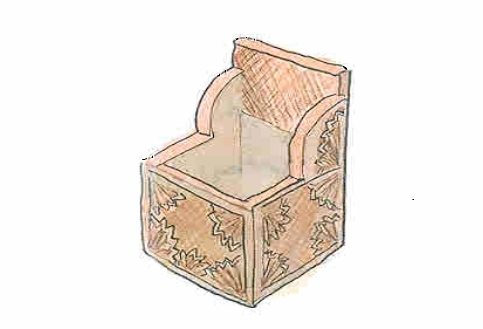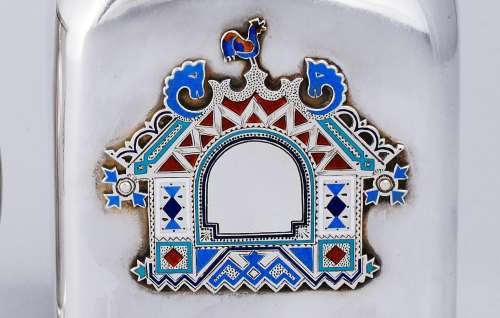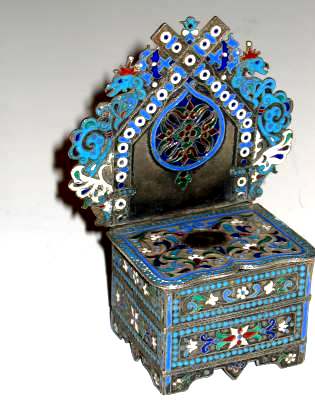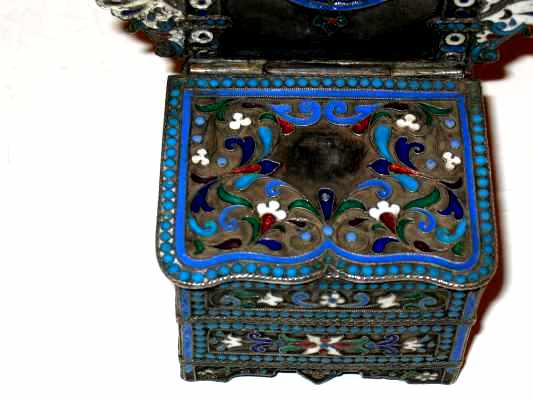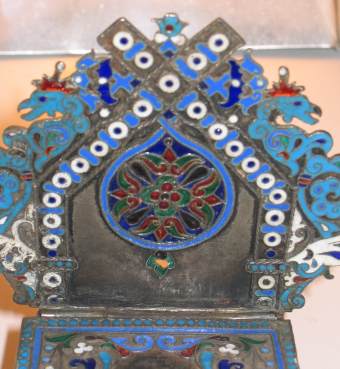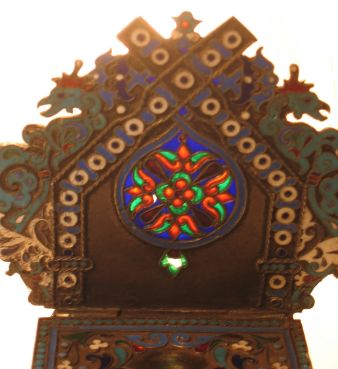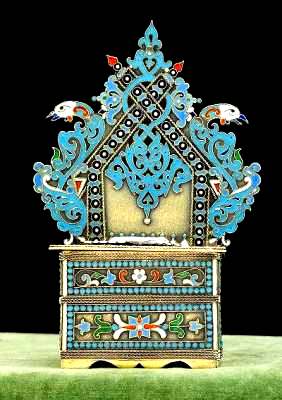 ASSOCIATION OF SMALL COLLECTORS OF ANTIQUE SILVER
ASSOCIATION OF SMALL COLLECTORS OF ANTIQUE SILVERASCAS
| article # 74 |
|
next |
previous |
(click on photos to enlarge image)A GIANT ENAMEL SALT THRONE FROM RUSSIA
|
The prototype, or basic shape of a salt chair, square and boxed, carved in wood, 19th century, most common in central Russia. All significant details are there, the expressed back, the bend between the seat and the back, and the fine ornaments. A repeated ornament is the circle (half and quarter with spokes, a sun, star or a wheel). The lid above the seat is missing, it is not a necessity, and this was added later. Height 13 cm, width and depth 10.2 cm (sketch after Alison Hilton). |
The demand for enamelled pieces of applied art, compared to similar pure silver art, came fairly late in Tsarist Russia, where enamelled pieces became more frequent in early 20th century, when enamelled tobacco cases, napkin rings, coffee-cups, teaspoons etc appear, most of them stamped in the period of 1908-1917. Also corpus art: bowls, kovsh, salt cellars, are mostly from this period.
One motive that appears in the salt throne representation is the old rural izba house with raised gable with wheels, ornaments of saw-tooth, finials with symbolic animals (birds, rooster or horses) protecting the house and its inhabitants.
A traditional Russian rural izba house here artistically represented in polychrome cloisonné enamelling technique on a silver tea caddy by Gratchev workshop, workmaster Johan Olsonius, St Petersburg 1880 (photo Uppsala Auktionskammare). |
Further, this piece is a forerunner and predecessor to what later comes of enamelled salt thrones, it is as early as 1887.
Enamelled salt throne by master P.R. (in Latin transcription) for Pyotr Rykovsky , stamped in Moscow 1887, assaymaster A. Romanov. 88 zolotniki silver content (916/000) and two enamelling techniques: the general surface cloisonné, but the cartoche at the back, and some minor additional features, is made in plique-a-jour (full translucent in small frames). The salt chair has an impressive size, heigth 12 cm, width 9 cm, depth 5.3 cm, weight 168 grams |
All four sides of the strong box-shaped throne are decorated with polychrome cloisonné in floral pattern ornaments, and the chair feet are Old Russian Style. The lid of the seat shows similar ornaments with a cartouche in the middle, not engraved. The translucent cartouche on the seat back is absolutely unique for a salt throne, and when seen in daylight it is most charming.
The translucent appearance of the cartouche of the seat back, with some added small plique-a-jour pieces below and integrated in the cloisonné pattern. |
Surprisingly, lately one enamelled salt throne by the same silversmith P.R. appeared, made the same year 1887. The size and style are the same, square boxed, izba gable, birds and rich ornamented seat back. Also, enamelling techniques, cloisonné, and plique-a-jour in the cartouche, have been used.
A similar salt throne by silversmith P.R. (Pyotr Rykovsky), Moscow 1887, 88 zoloniki silver standard, enamelled with cloisonné and plique-a-jour, height 14 cm (photo Stockholms Auktionsverk) |
This salt throne is a presentation gift of importance, it has not been used for salt ceremony purposes, it has been treasured as a prominent “objet de vértu”. It reflects the puristic tradition of Russian nationalism, and although it is very traditional in shape and symbolics, the intricate enamelling and the expressive size add a significant artistic touch.
Willand Ringborg © - 2007 - |
